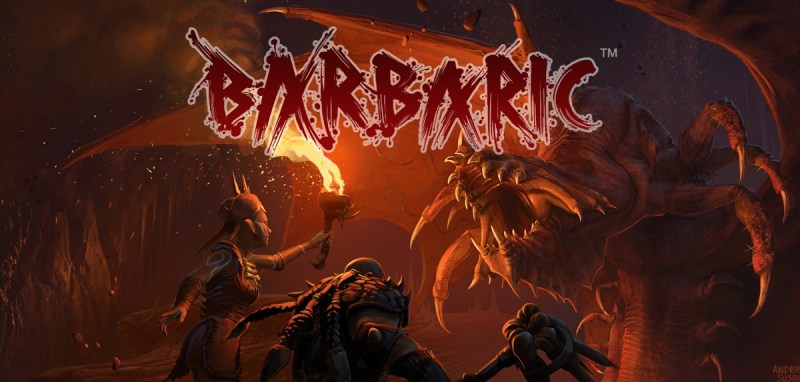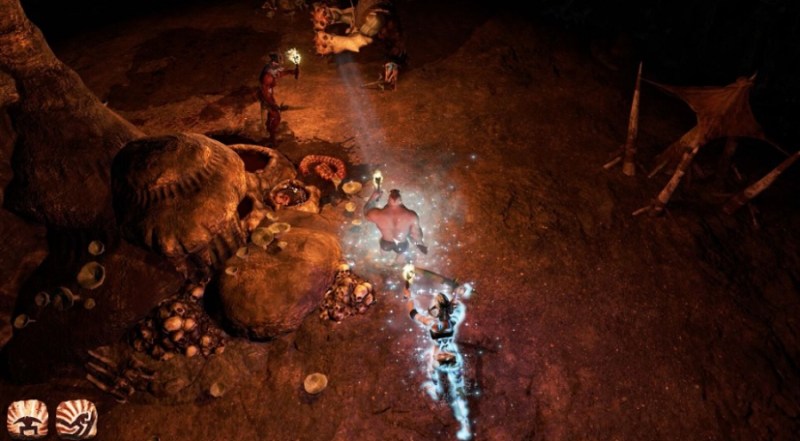It’s been a while since I heard the phrase “Triple-I,” an independent game studio’s variation on “Triple-A” video games. Then again, there haven’t been that many indie game studios that can claim they’ve been working on a really high-quality title for a long time.
But that’s how Scott Foe and Alessandro Tento, cofounders of Ignited Artists, are positioning their San Francisco game studio. The company recently unveiled Barbaric, a cooperative, multiplayer roguelike dungeon crawler. It has permanent death and procedural adventures that are different every time you enter the dungeon. As far as roguelike titles go, Foe believes that there is a lot of demand for a modern version of the old dungeon games.
Foe and Tento also say they wanted to build the “best place to work in the games industry.” That’s very big talk, but they mean they want to build a studio where developers can share in the success of the studio’s games. Sadly, that doesn’t always happen in the game business.
We talked with Foe and Tento (truthfully, Foe was the talkative one) about their game and studio. Here’s an edited transcript of our interview.
GamesBeat: I wanted to hear more about what you’re doing with the game and what Ignited Artists is all about. Can you take us back to the founding of the company?
Scott Foe: We felt, back in 2014, that we were going to experience a sea change in the way games were made, much in the way Hollywood experienced a sea change in the ‘20s, where less of the money was in control of the accountants, where directors and actors no longer had 20-picture deals, where they were basically studio slaves. We saw a new kind of independent rising that would have a lot of capital and 100 percent say over how that capital is deployed. Bigger than a basement company, smaller than an Activision. We saw these new independents as the future of games, enabled by all the new and easy distribution mechanisms that had cropped up in the decade before.
We wanted to build the greatest place to work in the games industry. We wanted to build a place where people would be happy to wake up and come to work. We wanted to build a place where everybody was very well-compensated for the games they make. We didn’t feel it was fair that someone could contribute to a $2 billion franchise and only make an ordinary salary. Chris Olson, over at Sega, shared our vision. He was kind enough, visionary enough to invest in us. We took it from there.
Today, I feel that we’ve achieved those goals. I feel this is the best working environment I’d ever participated in. Everyone here is really excited for the future of what’s come to be known — although we didn’t coin it — as “triple-I” development. A really big independent.
GamesBeat: Did you guys already have some source of funding when you started? Was Chris [Olson] the one who mainly provided funding?
Foe: It was a series A investment by Sega. We went from having people with Powerpoint slides, no team, no revenue, no product, to having a game studio that today is a really good game studio. Right now, we have a little over 30 people working on the game. Not everyone is in San Francisco. We have external workers in both South America and Europe. It’s really something to look at how far we’ve come.

Above: Ignited Artists’ Barbaric.
GamesBeat: San Francisco is where the main group is?
Foe: Yeah, San Francisco is definitely the headquarters.
GamesBeat: We had a boom in indie game companies following the arrival of the big app stores and then a thinning out that happened once user acquisition became more difficult. But to a large degree, successful developers have been able to take control of their destiny and maintain their independence. That seems to be a general industry trend for indies. Do you feel like you’ve followed that?
Foe: Well, our plan is certainly not to go out of business. We had the luxury of Chris at Sega sharing our vision and starting us out with a lot of money to get the snowball rolling downhill. It’s our intention to make that snowball bigger, to get more and more money, and do even more, bigger, and wilder projects. Most importantly, we want to make this the greatest place to work in the games industry. We would not be the slightest bit disappointed if other studios adopted our company handbook, our profit-sharing policies, and so on. We’re not just out to make a great game. We’re out to change the world.
GamesBeat: One question that begs to be answered: Did you happen to work at the worst places in the industry before this?
Foe: Far be it for us to guess what the worst place to work in the industry might be. Alessandro Tento himself has 30 years of experience in the industry, and even he hasn’t worked everywhere. But we were founded on the idea that for the money these companies make, there’s a disproportionate — and some might even say unfair — distribution of profits between creators and franchise owners. We hope to change that.
GamesBeat: You’re getting closer to your blog post there. Do you want to talk about that? Was there a particular timing that made you want to make that statement?
Foe: Everything that’s in there comes from the heart. Of course, it was timed to go with the game announcement, just to kind of rally up some interest. I’d like to thank my thousands of readers. I see you’re one of them, which makes me really proud. Hopefully, some people can find insight in there as well.

Above: Barbaric is a cooperative roguelike game.
GamesBeat: There’s this idea that game designers are the ones who have this ability to generate money for their studios. It’s within their control.
Foe: I feel that failure is a non-linear distribution. If you build a sandcastle and it all falls down, which grain of sand do you blame? That’s certainly true. But I also believe the old David Packard quote about how marketing is too important to be left to the marketing department. When I do encounter designers who — you have so many talks in this industry about making the game you love. If making the game you love is not going to feed yourself, your coworkers, and their families, you need to rethink the game you love.
Jim Collins gives us this idea of the hedgehog principle, where you take the thing you love and then take the thing you do well, but then there’s a third part of the Venn diagram, which is the thing that’s commercially viable. When you hit that in the center, all masters are served. That’s what you should be aiming for. You remind me, by the way, that I did my readers a disservice by not plagiarizing Jim Collins more in that blog post.
GamesBeat: How did you guys apply some of this general thinking to Barbaric, the game you’ve started to show?
Foe: Barbaric is for gamers who are dissatisfied by the shocking lack of multiplayer roguelikes out there. For anyone who loves dungeon crawling, we offer fast, fun dungeon crawling for you and up to three friends. To describe Barbaric as a dungeon crawler would be like describing Cirque du Soleil as the circus. It’s a circus, but it’s unlike anything you’ve ever seen.
A lot of times people don’t feel disruption until it’s right on top of them, so we’re using dungeon crawling, the most obvious facet of the experience, to explain it to people in words they can understand. When we hit market, I think you’ll be pleasantly surprised by the new experience we’re offering people.

